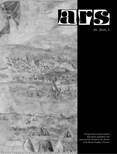
Journal ARS 49 (2016) 1
Ivana KVETÁNOVÁ
The Veduta of Possonia/Bratislava at the Palazzo Vecchio in Florence and its Hidden Story
(Summary)
One of the oldest images of Bratislava can be found in the first courtyard of the Palazzo Vecchio in Florence (Cortile di Michelozzo) (Fig. 1, 2, 3, 4). The mural painting titled “Possonia” (today’s Bratislava) was part of the cycle representing the views of 17 cities of Habsburg monarchy, commissioned in 1565 by Cosimo de’Medici for the wedding between his son Francesco and Giovanna d’Austria, daughter of Ferdinand I of Habsburg. The cycle was executed by Sebastiano (Bastiano) Veronese, Giovanni Lombardi Veneziano, Cesare Baglioni Bolognese, and Turino di Piamonte. Source materials necessary for the depiction of the individual cities were delivered by Hieronymus and Anton Krafter (Graffiter/Crafter), and Giulio Ricasoli, who was entrusted with providing the materials on Possonia. He could use a leaflet depicting Bratislava during the coronation of Maximilian II, which took place on September 8, 1563 (Fig. 6). The Possonia mural painting in Florence was most likely inspired by this image, signed by Monogrammist “HM” and “MG” (Fig. 6), i.e. Leipzig-based painter and graphic artist Hans Mayr (Meyer), or Martin and Donat Hübschmann. The existence of the leaflet must have been well known, as the commission (Archivio di Stato, Firenze), surprisingly enough, strictly specified that the model must represent the city during coronation. Both the leaflet and the mural painting show Bratislava from the south. In the foreground one can see the Danube river and its arms with encampments of guests and delegations, in the background there is a view of the city with the castle on the hill. Inside the fortification, one can recognise, for instance, St. Clare’s church, St. Francis’ church, St. Martin’s Cathedral, Michael’s Gate, and partially Vydricka and Laurinska gates, Fisherman’s Gate, Water Tower etc. (Fig. 7 a, b). In the print, the view of Bratislava and the scenes taking place during coronation festivities are completed with “notes” (local names, names of protagonists) and the text in verse describing the course of the celebration. The view of the city looks like a scenery with a number of scenes in the foreground; however, the depicted events actually took place within several days: arrival of king Maximilian and his entourage overland (August 31), arrival of bride’s father, Ferdinand I, by boat (September 1), location of individual camps, tournaments, games, competitions, and other festivities (Fig. 9, 10 a, b). The veduta did not show the coronation ceremony at St. Martin’s Cathedral. The only exception is a scene taking place on the coronation hill, which shows Maximilian on horseback, holding a sword in his hand (Fig. 11a, b). Based on a precise comparison of the details it is possible to verify whether the mural painting at the Palazzo Vecchio was made after the leaflet of 1563/1564. We compared the two printed versions of the leaflet (GMB-Bratislava, ÖAI - Wien), preserved photographs of the fresco before and after the restoration completed in the 1940s and 1950s (by Fratelli Benini, Fototeca di Comune di Firenze, Fig. 8), and the current condition of the fresco. The fresco shows many interesting versions of the scenes as well as some mistakes caused by either a misinterpretation or a simplification: originally numerous crowd is reduced to the maximum possible extent (Fig. 10 b); the volley cannons are directed, by mistake, at the city (Fig. 13 a, b); two boat bridges crossing the rives are depicted in a very simplified way (Fig. 15b). The coat of arms over the veduta differs from that of Bratislava. It was inspired by the coat of arms that appeared in the leaflet, for instance in the decoration of triumphal arches, which resembles the coat of arms of the Austrian kingdom (Fig. 15 a, b). The fresco shows tournaments abd games, such as conquering the wooden castle outside the city walls (September 12), however, today only the tower is visible. Many people were killed and injured by fire that broke out during the games (Fig. 12 a, b). The tournament (September 16), organised by Maximilian’s brother, Charles, has not been preserved in the mural. The restoration of Possonia fresco in Florence (Genten Firenze) made possible to examine all details. This paper has been written due to the support of the Slovak Historical Institute in Rome (SHÚR).